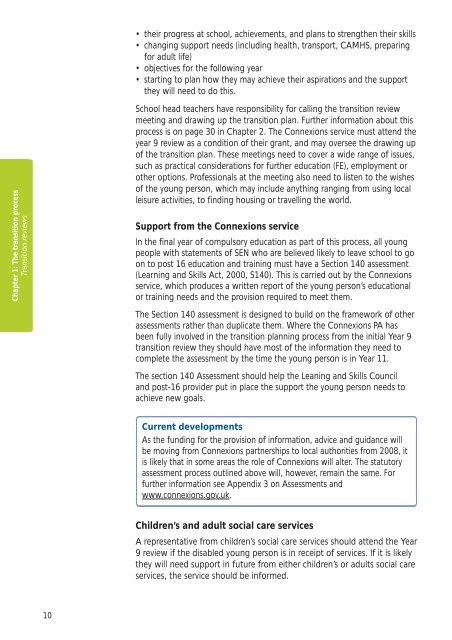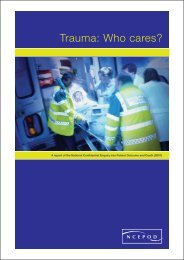A Transition Guide for All Services - Transition Information Network
A Transition Guide for All Services - Transition Information Network
A Transition Guide for All Services - Transition Information Network
- No tags were found...
You also want an ePaper? Increase the reach of your titles
YUMPU automatically turns print PDFs into web optimized ePapers that Google loves.
• their progress at school, achievements, and plans to strengthen their skills• changing support needs (including health, transport, CAMHS, preparing<strong>for</strong> adult life)• objectives <strong>for</strong> the following year• starting to plan how they may achieve their aspirations and the supportthey will need to do this.Chapter 1: The transition process<strong>Transition</strong> reviewsSchool head teachers have responsibility <strong>for</strong> calling the transition reviewmeeting and drawing up the transition plan. Further in<strong>for</strong>mation about thisprocess is on page 30 in Chapter 2. The Connexions service must attend theyear 9 review as a condition of their grant, and may oversee the drawing upof the transition plan. These meetings need to cover a wide range of issues,such as practical considerations <strong>for</strong> further education (FE), employment orother options. Professionals at the meeting also need to listen to the wishesof the young person, which may include anything ranging from using localleisure activities, to finding housing or travelling the world.Support from the Connexions serviceIn the final year of compulsory education as part of this process, all youngpeople with statements of SEN who are believed likely to leave school to goon to post 16 education and training must have a Section 140 assessment(Learning and Skills Act, 2000, S140). This is carried out by the Connexionsservice, which produces a written report of the young person’s educationalor training needs and the provision required to meet them.The Section 140 assessment is designed to build on the framework of otherassessments rather than duplicate them. Where the Connexions PA hasbeen fully involved in the transition planning process from the initial Year 9transition review they should have most of the in<strong>for</strong>mation they need tocomplete the assessment by the time the young person is in Year 11.The section 140 Assessment should help the Leaning and Skills Counciland post-16 provider put in place the support the young person needs toachieve new goals.Current developmentsAs the funding <strong>for</strong> the provision of in<strong>for</strong>mation, advice and guidance willbe moving from Connexions partnerships to local authorities from 2008, itis likely that in some areas the role of Connexions will alter. The statutoryassessment process outlined above will, however, remain the same. Forfurther in<strong>for</strong>mation see Appendix 3 on Assessments andwww.connexions.gov.uk.Children’s and adult social care servicesA representative from children’s social care services should attend the Year9 review if the disabled young person is in receipt of services. If it is likelythey will need support in future from either children’s or adults social careservices, the service should be in<strong>for</strong>med.10
















